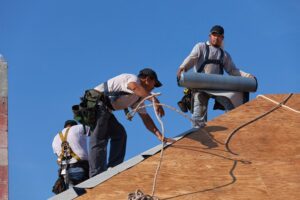
In the world of commercial buildings, the roof plays a vital role in protecting the structure and its contents from the elements. Over time, however, wear and tear can take a toll on even the sturdiest commercial roofs, eventually necessitating replacement. In this article, we will explore the need for roof replacement, how to choose the right roofing material, the process of roof replacement, the cost and financing options available, and the importance of hiring a professional roofing contractor.
Understanding the Need for Roof Replacement
When it comes to commercial roofs, recognizing the signs that replacement is necessary is crucial. Ignoring these signs can lead to further damage to the building and its contents. Some of the key indicators that your commercial roof needs replacement include:
Signs Your Commercial Roof Needs Replacement
- Leakage: If you notice water stains on the ceiling or walls, it could be a sign that your roof has leaks.
- Wear and Tear: Excessive cracking, blistering, or curling of the roof’s surface indicates that it has reached the end of its lifespan.
- Poor Insulation: A sudden increase in energy costs or inconsistent temperature control could be due to inadequate insulation caused by a deteriorating roof.
- Mold Growth: The presence of mold or mildew on the roof or inside the building suggests that moisture is seeping through a damaged roof.
The Lifespan of Commercial Roofs
The lifespan of a commercial roof depends on various factors, including the type of roofing material used and the level of maintenance performed. On average, commercial roofs can last anywhere between 20 to 50 years. However, extreme weather conditions, poor installation, and lack of maintenance can significantly reduce this lifespan.
It’s important to note that regular inspections and maintenance can help extend the lifespan of your commercial roof. By addressing minor issues promptly, you can prevent them from escalating into major problems that require costly replacements. Additionally, proper ventilation and drainage systems play a crucial role in preserving the integrity of your roof.
When considering a roof replacement, it’s essential to consult with experienced professionals who can assess the condition of your current roof and recommend the most suitable materials and solutions for your specific needs. Investing in a high-quality roof replacement not only enhances the aesthetic appeal of your building but also provides long-term protection against the elements, ensuring the safety and comfort of occupants.
Choosing the Right Roofing Material
Choosing the right roofing material for your commercial roof replacement is essential for long-term durability and cost-effectiveness. It is crucial to consider various factors when making this decision, as the roofing material plays a significant role in the overall performance and longevity of your commercial building.
One important aspect to consider is the environmental impact of the roofing material. Some materials are more sustainable and eco-friendly than others, contributing to energy efficiency and reducing the building’s carbon footprint. For example, metal roofing is often made from recycled materials and is fully recyclable at the end of its lifespan, making it a sustainable choice for environmentally conscious businesses.
Comparing Different Roofing Materials
When comparing roofing materials, factors such as lifespan, maintenance requirements, energy efficiency, and cost should be taken into consideration. Each type of roofing material has its unique characteristics and benefits that cater to different needs and preferences.
- Single-Ply Membrane: Provides excellent flexibility, durability, and resistance to UV rays. It is a popular choice for commercial buildings due to its ease of installation and cost-effectiveness.
- Metal Roofing: Known for its longevity, energy efficiency, and resistance to extreme weather conditions. Metal roofs can last 50 years or more with proper maintenance, making them a durable option for commercial properties.
- Built-Up Roofing (BUR): Consists of multiple layers of bitumen and provides exceptional waterproofing capabilities. BUR systems are known for their strength and ability to withstand harsh weather conditions.
- TPO (Thermoplastic Olefin): Offers high reflectivity, energy efficiency, and resistance to puncture and tears. TPO roofs are lightweight yet durable, making them a popular choice for commercial buildings seeking energy savings.
Factors to Consider When Choosing Roofing Material
When selecting the appropriate roofing material for your commercial building, factors such as the building’s location, climate, budget, and aesthetic requirements should be carefully evaluated. The geographical location of your building can impact the choice of roofing material, as certain materials perform better in specific climates.
Additionally, the budget allocated for the roof replacement project is a crucial factor to consider. While some roofing materials may have a higher upfront cost, they could result in long-term savings through energy efficiency and reduced maintenance expenses. It is essential to weigh the initial investment against the potential long-term benefits of each roofing material.
Consulting with a professional roofing contractor is highly recommended to gain valuable insights and recommendations tailored to your specific needs. A knowledgeable contractor can assess your building’s requirements and provide expert guidance on selecting the most suitable roofing material that aligns with your budget, aesthetic preferences, and performance expectations.
The Roof Replacement Process
The roof replacement process involves several steps that ensure a seamless and successful installation.
Preparing for Roof Replacement
Prior to the roof replacement, it is essential to plan and prepare for the project. This includes:
- Obtaining permits and ensuring compliance with local building codes
- Protecting the building’s interior and contents from potential damage
- Arranging for temporary relocation of equipment or personnel, if necessary
Steps Involved in Roof Replacement
The roof replacement process typically involves the following steps:
- Removal of the existing roof
- Inspection and replacement of any damaged decking or insulation
- Installation of the new roofing material
- Sealing and waterproofing the roof
- Cleaning up the job site and ensuring proper disposal of old roofing materials
Cost and Financing of Roof Replacement
The cost of commercial roof replacement varies depending on various factors such as the size of the building, the roofing material selected, and the intricacy of the project. Obtaining a detailed estimate from a professional roofing contractor is essential to determine the exact cost.
Estimating the Cost of Roof Replacement
The cost of roof replacement is typically calculated per square foot. However, other factors such as the condition of the existing roof, access to the building, and additional requirements can also influence the final cost. It is crucial to obtain multiple quotes and compare them to ensure you are getting the best value for your investment.
Financing Options for Roof Replacement
Roof replacement is a significant investment, and financing options are available to make it more manageable. These options include:
- Traditional Bank Loans
- Business Line of Credit
- Equipment Financing
- Contractor Financing Programs
Hiring a Professional Roofing Contractor
Hiring a professional roofing contractor is crucial for a successful roof replacement project. A reputable contractor will have the necessary expertise, experience, and resources to ensure a seamless installation.
Qualities to Look for in a Roofing Contractor
When selecting a roofing contractor, consider the following qualities:
- Proper licensing and insurance
- Experience in commercial roof replacement
- Positive reviews and references
- Detailed proposals and warranties
The Role of a Contractor in Roof Replacement
A roofing contractor plays a critical role throughout the roof replacement process. They will assess your roof’s condition, provide recommendations on suitable roofing materials, oversee the installation process, and ensure compliance with safety regulations and building codes.
By understanding the need for roof replacement, selecting the right roofing material, following the proper roof replacement process, considering the cost and financing options, and hiring a professional roofing contractor, you can ensure that your Trumann commercial building is protected by a durable and reliable roof for years to come.
Don’t let the threat of water damage to your Trumann commercial property keep you up at night. Trust the expertise of Commercial Roofing Rana, serving the Mid-South since 1983, to provide you with a roofing system that stands the test of time. Our Duro-Last roofing systems are precision-engineered to offer the ultimate protection for your business. Whether you manage an industrial facility, a retail store, or a municipal building, our licensed professionals are equipped to handle the complexity of your commercial roofing needs. Ensure your property’s best line of defense is in top condition. Schedule Now! and let us secure your investment against the next rainstorm.
